The entomological discovery of the century was made on January 2nd, 1975 by a textile engineer with no college degree. His name was Kenneth Brugger, and his proudest professional accomplishment was inventing no-shrink underwear, which truly is a pretty proud accomplishment in my book—but he will be remembered for something far greater.
The story begins almost four decades earlier. It was 1937, and two Canadian zoologists named Fred and Norah Urquhart were obsessed with solving a mystery that had stumped scientists for over a century. In five words, here’s what the mystery was:
Where do the monarchs go?
All summer they dance and weave in abundance above the plains and hills of the United States and southern Canada. They drop into our backyards and flit around our roadsides. There are millions and millions of them. But then in the fall, they vanish, and in the spring they return. And no one could figure out where they went.
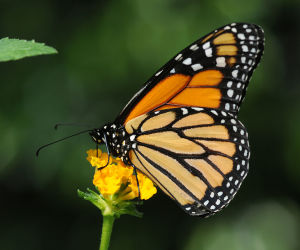
-
Monarch Butterfly (Danaus plexippus)
Thomas Bresson CC 2.0, via Wikimedia Commons
Scientists knew that they were migrating. They even knew that they were overwintering somewhere in congregations, because that’s what the ones west of the Rocky Mountains do, at sites in coastal California like our old stomping grounds, the Monterey Peninsula. But the ones east of the Rockies just vanished. Every year a whole continent’s worth of butterflies disappeared. Somewhere out there, over a billion monarch butterflies were congregating together for the winter.
And nobody could find them.
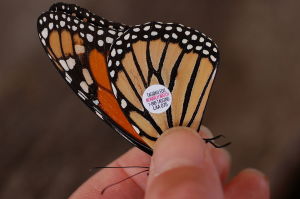
-
Tagged Monarch
Photo by Derek Ramsey[GFDL 1.2], via Wikimedia CommonsThe Urquharts started by attacking a fairly tricky problem no one had solved yet: How to tag a monarch butterfly. They only weigh about as much as a paper clip, and effortless flight means everything to them. How do you tag such a creature? They traveled to the Monterey Peninsula, and tested tagging methods on the overwintering population there in Pacific Grove. They endured several years of failures, and finally succeeded with a tiny self-adhesive dot-shaped label placed on the underside of the hind wing. They started tagging. After several years of grinding away at this themselves, they took it to the next level, and started recruiting volunteers, launching what today would be called a “citizen science” project. Hundreds of butterfly lovers and school children tagged thousands of butterflies every year—and they had to tag them every year, because monarchs don’t live longer than that. In that sense this was an unrelenting project they’d gotten themselves into—after seven or eight months every animal you’ve tagged is dead, and you have to start over. But they and the volunteer troops kept persevering, and the data started trickling in. The monarchs began coming back to them in the mail, some dead, some alive and lovingly packed among wildflowers in perforated boxes. They got letters. They got phone calls. One tagged monarch alighted on a golf ball an instant before the golfer smacked both of them to kingdom come. He mailed the body in. They started sticking pins in a great map. The years went by, and the flight paths began to materialize. The lines were all converging toward Texas. It was looking like a run for the border.
They started placing ads in Mexican newspapers. In 1972 Kenneth Brugger picked one of them up.
* * * *
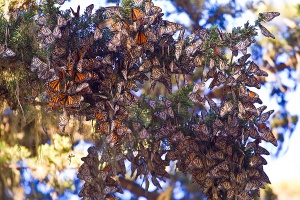
-
Monarchs Overwintering in Pacific Grove (a tagged individual is visible in upper center)
Photo by Agunther (Own work) CC 3.0, via Wikimedia Commons
Kenneth had gone through a divorce and re-crafted his life. He had quit his job working for the Jockey underwear company in Kenosha, Wisconsin, and moved to Mexico City as a textile consultant. And when he read the ad, a memory came back to him. He remembered driving once through the high elevations of the Sierra Madre mountains and suddenly finding himself inside a great cloud of monarch butterflies. He wrote the Urquharts. I think I can help, he said.
He had struck up with a Mexican woman named Catalina Aguado. He was 53 and she was 21, and she shared his love of nature. Together they began spending their weekends roaming the Sierra Madres looking for the butterflies. They had a Winnebago, and they would hike through the days and sleep in the RV. They were in frequent contact with the Urquharts, who encouraged them and advised them. They were seeing tantalizing signs—a transient cloud here, a roadside littered with bodies there. The signs were pointing toward Michoacan state. They talked with locals. They continued looking. In 1974 they got married.
The moment finally came when they were climbing a peak called Cerro Pelon. They ascended past the 10,000 foot level and crossed a clearing toward a stand of oyamel fir trees, and when they drew close they realized that every tree was cloaked in monarch butterflies. I picture them both standing speechless. The butterflies hung in festoons from every bough, they covered every trunk, they carpeted the ground, and clouds of them danced through the air in front of their faces. Fred Urquhart remembers getting the call. “We have located the colony!” Kenneth said. “We have found them—millions of monarchs—in evergreens beside a mountain clearing.”
I am certain that that scene was, to Kenneth Brugger, a spectacle of breathtaking beauty which he never forgot, but actually, the orange of the butterflies was not something he could see. He was completely colorblind.
* * * *

-
Monarch Butterfly Biosphere Reserve
By Luis Avalos (Own work) [CC BY-SA 3.0], via Wikimedia Commons
Really, Kenneth Brugger solved two mysteries. Indigenous peoples in those mountains like the Purepecha, the Otomi and the Mazahua knew all about those monarch colonies. In fact, they revered them. The monarchs were part of their folklore and their spirituality. They rang the church bells when the monarchs arrived, usually around the Day of the Dead, and they considered them to be the souls of their ancestors. They knew all about those butterflies, but they didn’t talk about it much to outsiders. And they didn’t know where in the heck they disappeared to in the spring.
They all got their lives changed by this discovery. They now live in the middle of a World Heritage Site called the Monarch Butterfly Biosphere Reserve, amid throngs of tourists.
* * * *
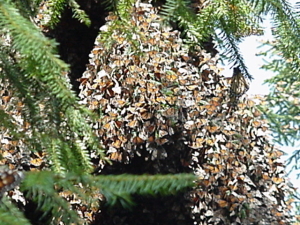
-
Monarchs at the Monarch Butterfly Biosphere Reserve in Michoacan, Mexico
By Bfpage at en.wikipedia [Public domain], from Wikimedia Commons
The monarchs cannot overwinter just anywhere. They’re extremely particular. The area must have trees to roost in, whose foliage and canopy protects them from direct snow and wind. It must be close to freezing, so that their metabolisms slow and they don’t use up the reserves they will need for the return flight. But it cannot be too cold, or they will have to turn on the furnace to keep from freezing to death, and that uses up reserves too. There must be underbrush for safety, because when they fall to the ground, which happens a lot when it’s close to freezing and you’re in a stupor, it is usually too cold for them to fly back up to escape predators like mice, but they can crawl up into the understory. It must have streams or some other water source to drink from, and it also must have fog, again to keep them hydrated, because they can only fly to the water source during warm hours on warm days, and they must return to the roosting tree before it gets too cold to fly, and they get very jumpy about that. Sometimes you can watch an entire cloud of monarchs rise from a water source all at once and return to the trees, just because a cloud has passed in front of the sun.
In Mexico, all these requirements limit them to just a dozen small oyamel forests in the Sierra Madres, which occur on a few mountain tops, above 10,000 feet, and facing southwest. So there is great concern about the deforestation that is happening, due to illegal logging. But let me mention here that the locals who do that are subsistence farmers living on communally-owned “ejito” land and have been relying for generations on these forests for lumber and firewood. It’s up in the United States that monarch habitat is being wiped out systematically by huge corporations, and it’s a much more dire problem. More on that in a bit.
* * * *
As spring approaches and the days get longer and warmer they begin to get restless, and clouds of them fill the air. The males pursue the females up into the sky and grapple with them, pulling them in long, fluttering paths to the ground, where they mate, remaining attached for up to an hour. They have not eaten since they arrived in the fall, and they have a long journey ahead of them. Mated females begin leaving first, usually the second week of March, and it has to be timed perfectly. If they leave before the milkweed has sprung up in the U.S. and Canada, the cycle will fail, because they have to lay their eggs on milkweed. Nothing else will work for the caterpillars when they hatch.
The females make it about halfway up the United States, laying eggs in milkweed patches all along the way, and then they die. The males don’t make it as far. They start dropping right away. Unromantic fact: Evolution doesn’t usually knock itself out prolonging the life of a male who has already mated. We become superfluous. (In some cases we become a protein source for the female, but monarchs don’t do that.)
The eggs hatch and within five weeks there is a new wave of monarchs, and they fly north, continuing the migration. This generation might make it as far as southern Canada, and again, they are laying eggs on milkweed patches as they pass, sending new waves of monarchs into the skies across the North American landscapes. There will be a couple more generations like this through the summer, and finally the whole continent is repopulated, shimmering and glinting with monarchs again, and then something interesting happens. When the very last generation emerges from their chrysalises in late August or early September, they have developed differently. Their wings are slightly larger. The veins in their wings are thicker. Their bodies are heavier and can store more fat. They will live for seven or eight months instead of a few weeks. Their sexual maturation has been put on hold. These butterflies are not about mating, they are about flying. That’s because the trip south is not a multi-generational affair like the trip north was. They’re in this for the long haul. For some of them it will be over three thousand miles—then they must survive the winter, then they must fly most of the way back. These are the elite athletes, the ultra-marathoners. These are the super-butterflies.
And the amazing thing is that these are the great-great-grandchildren of the butterflies who left the Sierra Madres. Not a single butterfly in this migration has ever flown the route before. And they’re going to find a small grove of trees thousands of miles away in the middle of a mountain range they’ve never seen. Scientists haven’t cracked that one yet. No one knows how they do it.
They only fly during the day. They roost in trees at night, at what are called waystations, in smaller congregations than the final one, but still a delight to behold. As they move south and converge toward the border, the ribbons of butterflies in the sky thicken and broaden, and there are places in Texas where the sight can take your breath away.
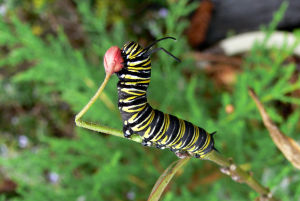
-
Monarch Caterpillar
Photo by Linda Tanner, [CC BY 2.0], via Wikimedia Commons
They don’t have many predators. One reason for their fondness for milkweed is that it contains chemicals called cardenolides, which are steroids that taste nasty and arrest your heart, and the caterpillars not only eat it without getting poisoned, but they proceed to co-opt the chemical, and put it to use in their own systems as a defense against predation, and it persists into the adult butterflies. Both caterpillar and butterfly have bold markings that are considered warning coloration. The viceroy butterfly (Limenitis archippus ) looks almost identical to the monarch, and I was taught growing up that it was a case of Batesian mimicry, and the viceroy was getting a free pass while not really being toxic himself. But there is now evidence that the viceroy is even more toxic than the monarch, which actually makes it a case of Mullerian mimicry, in which both species are dangerous, and have found it advantageous to advertise that fact with the same signals.
Here’s the bad news: In 1996 a little over a billion butterflies overwintered in Mexico. In 2013 there were thirty-three million. That’s a drop of 97%. According to a non-profit called Journey North, there is a whole range of causes, including the deforestation I mentioned, a series of unfortunate climatic events, ordinary loss of habitat due to development, and even ecotourism isn’t helping. But the problem that really frosts me is the one about the milkweed, because that’s one which, at least in theory, we could fix if we wanted to. Here’s what’s going on:
There are 115 species of milkweed, and the monarchs can use any of them. They grow like weeds in a variety of habitats from swampy to arid, and they do well on roadsides, field sides and other disturbed areas. You’d think there would be worse plants to hitch your wagon to. But what happened to the monarchs is genetically modified crops.
There are now genetically modified corn and soy bean strains in wide use which are resistant to an herbicide called glyphosate (you know it by its brand name, Round-Up). This allows the agriculture industry to spray it liberally on their fields, where it neatly kills everything but the crops. The problem is, the vast majority of monarch habitat had been in the sprawling farmlands of America, especially the corn belt. It was between the rows of crops, around the edges of fields, hugging the fence posts, in odd corners behind sheds and structures—milkweed is one of those plants that pops up in any unused space in the agrarian landscape. And according to Monarch Watch, the Midwest monarch habitat is “virtually gone,” with 80 million acres lost in recent years. Dr. Chip Taylor remains upbeat. “Numbers are really down,” he says, “but the monarchs will come back.” And I’m glad Monarch Watch has an optimistic director. We need optimists.
If you want to help, you can plant a monarch garden. Monarch Watch can set you up with a monarch garden kit, and show you how to plant your own little monarch waystation habitat with milkweed for the caterpillars and all the right wildflowers for the adults.
* * * *
It seems like way too many of my articles have a sad ending. But I believe in looking at the joy when we can, and the story of finding the monarchs is a captivating and uplifting drama. It was many years ago now. Of the four players in the tale, only Catalina is still with us, but all of them will be remembered. So that’s the image I’ll leave you with: Catalina Aguado and Kenneth Brugger walking out into a high-altitude clearing in the Sierra Madres, and staring in stunned silence at millions and millions of beautiful monarch butterflies.
Now you know.

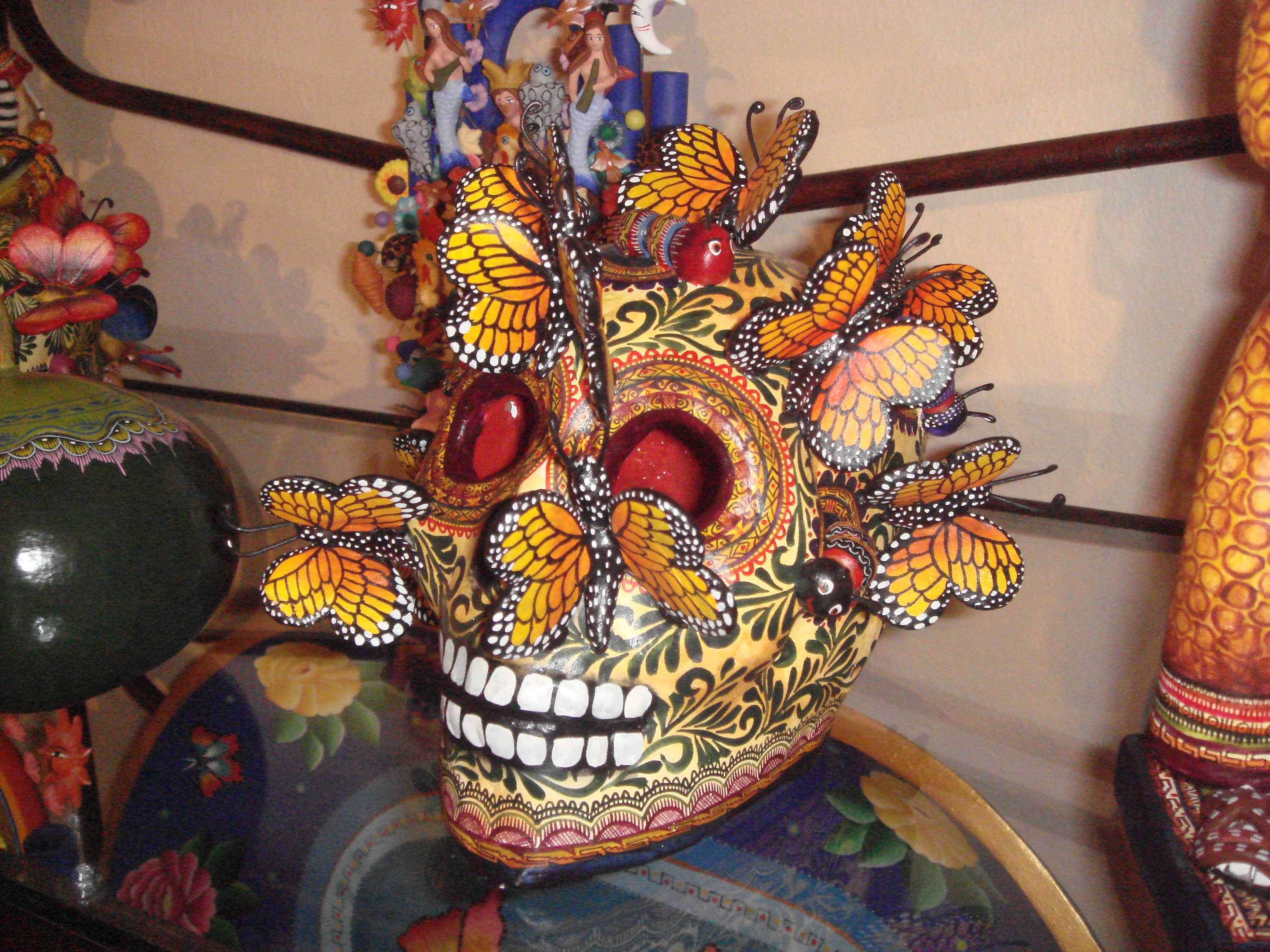
Thanks, By!
Holy cow.
I’ve read about the Monarchs many times—and visited their grove on the coast North of Santa Cruz—but never understood that the Northern migration is basically a genetic bucket brigade. How the hell is it that the great-grandchildren can emerge, basically, as a different species with a different life cycle entirely—built for a southbound marathon?
And how they navigate the migration South is a really juicy mystery, as is migration in general. Magnetic fields? Genetic memory? Gravitational anomalies?
What an amazing thing is Ma Nature and the mechanisms of cause and effect. Almost as stupifying as our inability to reign in GMOs and companies like Monsanto.
Thanks for the great read, bro!